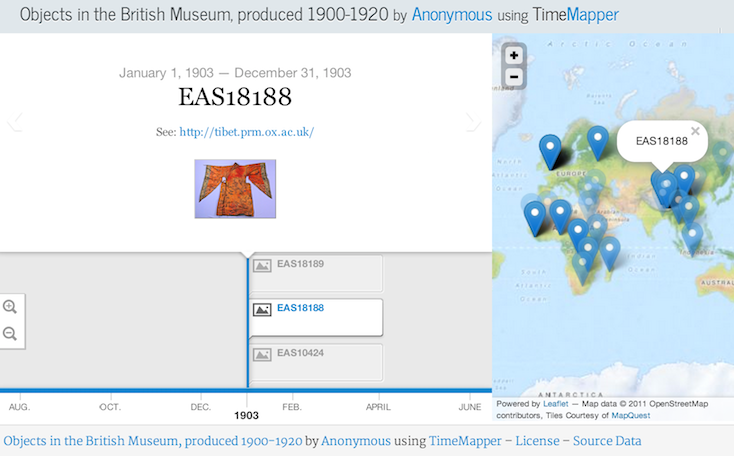An experiment with cultural open data using TimeMapper
I missed a session at the ODI on Friday about cultural open data, but luckily my colleague John Davies did make it. It turns out there’s a whole world of interesting cultural data out there, including the British Museum’s SPARQL endpoint.
SPARQL is query language (like SQL) designed to query ‘RDF triples’, which are basically just a way of describing knowledge as a graph of connected objects and relationships, each of the form:
<subject> <predicate> <object>
So you can say things like
<Andrew> <is_a> <Economist>.
Anyway, I had a play with the British Museum’s catalogue on Friday. It seemed cool, but what I really wanted to do, given the nature of the museum’s collection, was visualise something in both space and time.
The weekend passed, and this evening I caught a tweet from the Open Knowledge Foundation Labs about something called TimeMapper. Just what I was looking for.
@OKFNLabs .@OKFNLabs #TimeMapper app http://timemapper.okfnlabs.org now has a nice tutorial video showing how to make a #TimeMap in less than 1m
A short time later I have something working, which, while a bit rough around the edges, is pretty amazing for two hours of work (one of which I was really watching Homeland). So I present to the world
(Some of) The objects in the British Museum which were produced in 1900-1920 (a guaranteed viral hit)
Tools like TimeMapper are starting to make this sort of thing just incredibly easy. The only challenge was that the British Museum seems to have a very rubbery concept of location, so geocoding involve a fair bit of manual recombination of different location data. (That’s also why I’ve chose a modern time period—geocoding places destroyed by barbarian hordes a millenium ago is too great a challenge for a Sunday night.)
The SPARQL query is here: http://pastebin.com/98aYb6Qc
The google sheet is here: http://goo.gl/iABf7N

Add comment
Comments are moderated and will not appear immediately.